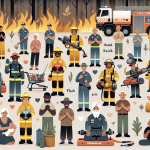Wildfires, often referred to as bushfires in Australia, have been a significant environmental and societal challenge for decades. With the growing threat posed by climate change, experts are ringing the alarm bells louder than ever. Australia needs advanced fire technologies to effectively combat these disasters, and many are now urging for substantial increases in funding to make this a reality.
Bushfires not only devastate natural landscapes but also jeopardize human lives, destroy homes, and kill wildlife on an unimaginable scale. As fire seasons grow longer and more intense, it is evident that traditional firefighting techniques can no longer keep up. What Australia needs is a cutting-edge, tech-driven approach to mitigate this crisis.
The Growing Impact of Bushfires
The damage caused by bushfires has reached unimaginable levels in recent years. The 2019-2020 bushfire season, often referred to as “Black Summer,” was one of the most catastrophic events in Australia’s history. Here’s the toll it took on the nation:
- Over 18 million hectares of land burned.
- 3,000 homes destroyed and countless others damaged.
- 33 human lives lost and over 1 billion animals killed.
- An estimated $100 billion in economic losses and environmental damage.
These staggering figures highlight the urgent need for advanced solutions. Climate change is fueling harsher conditions, with prolonged droughts, rising temperatures, and increased wind speeds sparking uncontrollable fires. In this environment, Australia cannot afford to rely solely on conventional firefighting.
The Role of Advanced Fire Technologies
So, what exactly are advanced fire technologies, and how can they help? These technologies combine innovations in science, engineering, and data analytics to better predict, prevent, and manage bushfires. Below are some examples:
1. Fire Detection and Monitoring Systems
Advanced detection systems use satellites, drones, and sensors to identify fires in their early stages. Real-time monitoring can save invaluable time, enabling a quicker response to minimize damage. For instance:
- Satellites equipped with thermal imaging detect hot spots from space.
- Drones fitted with infrared cameras provide a closer look at fire-prone areas.
- Artificial Intelligence (AI) models analyze patterns to predict fire incidents.
2. Predictive Modelling
By leveraging big data and analytics, predictive modeling helps scientists and emergency responders forecast the trajectory, speed, and intensity of bushfires. This technology enables better resource allocation and evacuation planning.
3. Autonomous Firefighting Vehicles
Unmanned firefighting drones and vehicles are becoming a game-changer. These devices can operate in dangerous conditions where it’s unsafe for human firefighters. They’re particularly useful in extinguishing high-risk fires in remote or highly volatile areas.
4. Water Bombing Aircraft & Retardants
The advancement of aerial firefighting via larger, more efficient waterbombing aircraft and fire retardants plays a crucial role in stopping fires from spreading. Some planes can carry up to 15,000 liters of water per trip, covering vast areas in minimal time.
5. Community Alert Systems
Modern notification technologies deliver real-time alerts to residents, helping them prepare early or evacuate when necessary. Smartphone apps, GPS alerts, and even social media platforms are now vital tools for public safety.
6. Fuel Management Technologies
High-tech tools like autonomous ground equipment and controlled burn simulation systems are helping manage flammable vegetation, reducing the risk of disastrous blazes.
Why Experts Are Calling for Increased Funding
While these advancements offer hope, their implementation comes with a hefty price tag. Experts are calling for increased government and private sector investment in these technologies to ensure widespread adoption. Here’s why boosting funding is essential:
- Development Costs: Developing and testing new technologies requires significant financial backing.
- Deployment Challenges: Distributing these resources on a national scale is both complex and expensive.
- Training: Firefighters and emergency personnel need proper training to operate advanced tech effectively.
- Research and Innovation: Funding research institutions will lead to continuous advancements in firefighting technologies.
- Community Engagement: Raising awareness and ensuring that communities can access hands-on tools requires sustained funding.
Without sufficient financial support, the majority of advanced technologies will remain limited to pilot projects or short-term trials, rather than being deployed on a wider scale.
How Increased Funding Can Transform Fire Response
With adequate investment, advanced technologies could drastically improve Australia’s capabilities to combat bushfires. Here’s how:
1. Faster Response Times
Thanks to early detection systems and predictive modeling, firefighters can respond faster and more effectively. Stopping small fires early prevents them from escalating into large-scale disasters.
2. Reduced Casualties
Innovative alert systems ensure that communities receive reliable information to protect themselves. Coupled with improved evacuation planning, this can save countless lives.
3. Preserving Biodiversity
Australia’s wildlife suffers immeasurably during bushfires. Advanced technologies, such as habitat monitoring and protective measures, can mitigate the destruction of ecosystems that are home to endangered species.
4. Economic Benefits
Though the initial cost of advanced technologies is substantial, the long-term savings outweigh the expense. Reducing fire-related destruction means saving billions of dollars in reconstruction, insurance claims, and healthcare costs.
Government and Community Collaboration
Fighting bushfires isn’t solely the responsibility of firefighters or government agencies. It requires a collaborative approach that includes local communities, private organizations, and even individuals. Here’s how everyone can contribute:
- Government: Provide consistent funding for fire technology research and development and deploy resources strategically.
- Businesses: Partner with tech companies to innovate solutions and bring them to market faster.
- Community Members: Stay informed, follow safety protocols, and participate in local fire preparedness programs.
A Final Call to Action
Australia’s bushfire crisis is a glaring reminder of the urgent need for increased investment in advanced fire technologies. While traditional firefighting methods are essential, they’re no longer enough in the face of worsening climate conditions and more frequent fires.
Experts are clear: without substantial funding, Australia risks falling behind in the battle against bushfires. By embracing innovation, developing new tools, and equipping emergency services with cutting-edge technology, the country can not only reduce the devastation caused by these disasters but also save lives, property, and its unique ecosystems.
This is a call to action for every level of society—government, industry, and the average citizen. Let’s work together to ensure that Australia is prepared for the fire seasons of tomorrow. After all, protecting our future starts with the decisions we make today.
“`


